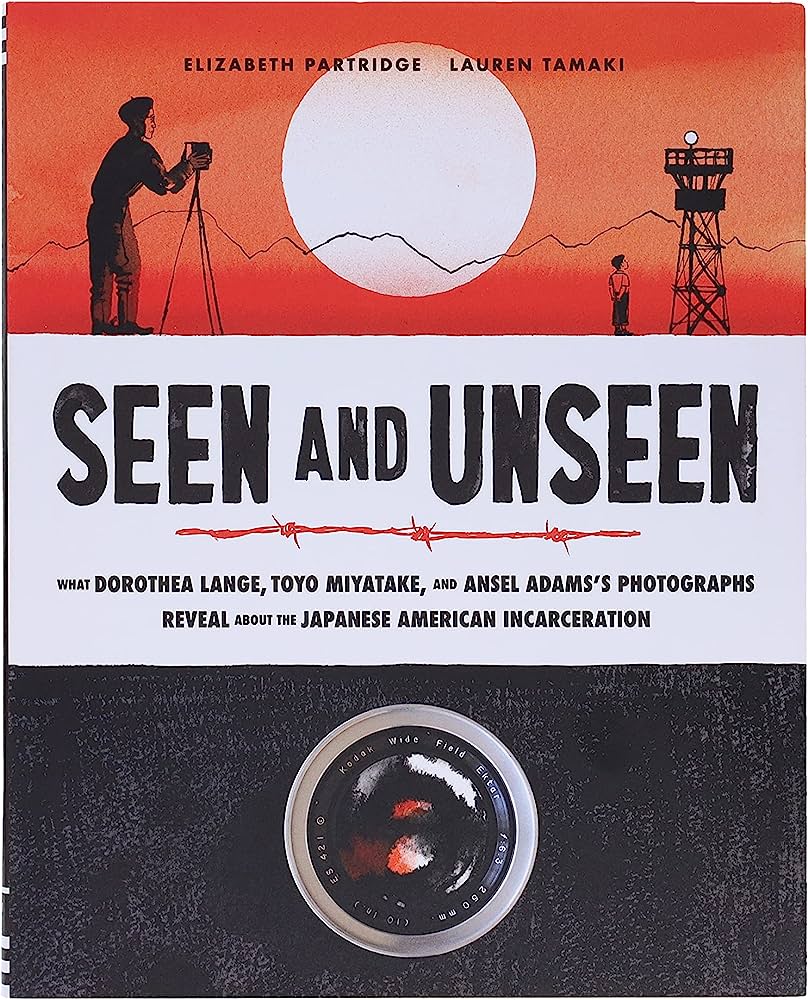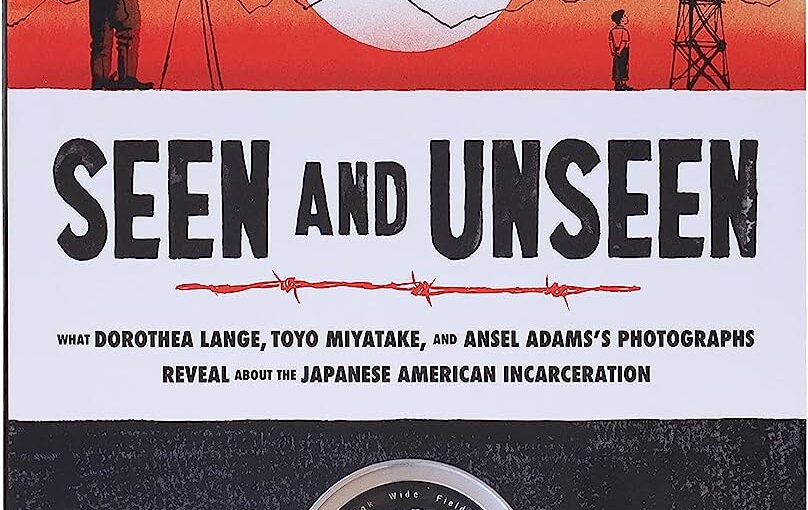Ansel Adams only photographed mountains, didn’t he? Yeah, I thought that, and you might’ve also. That’s how Seen And Unseen, What Dorothea Lange, Toyo Miyatake, and Ansel Adams’s Photographs Reveal About the Japanese American Incarceration caught my attention. Seen And Unseen is by Elizabeth Partridge with illustrations by Lauren Tamaki and provides an impressive overview of Japanese Americans who were imprisoned in Manzanar in the aftermath of the bombing of Pearl Harbor.

It’s a non-fiction look at the paranoia that happened after the United States officially entered WWII and its impact on Japanese Americans. There were more than 120,000 Japanese Americans, Issei as they were called, who were ordered to detention centers, and then transported to prison camps. Lange, Myatake, and Adams are each provided with roughly a third of the book in which their photographs are presented.
Each photographer’s work is complemented with illustrations by Tamaki that are similar to the ones on the book’s cover. They’ve got a very sharp, crisp outline that appears to have been done in ink, watercolor, and pencils. That combination offers a realistic approach that ensures audiences take note of the book’s serious storyline while making it approachable and not off-putting. It’s a tough line to navigate, but Seen And Unseen does that in telling a slice of history that most people have only heard about in passing conversation.
Because the book is broken up into thirds it allows for different aspects of the story to shine and easily be distinguished. Lange was an American photographer hired by the government to document conditions at Manzanar. Most of her photographs were never seen by the public and were confined to military files. Miyatake was a Japanese American photographer who had a studio in Los Angeles before he and his family were shipped to Manzanar. As their morale got worse while being kept there, the prison administrators decided that it would make things more palatable if someone took their photos. It became his job to take family photos and document celebrations like New Year mocha making, but all of the photographs had to be signed off on by the prison leaders.
Adams was hired by the leaders of the prison in the fall of 1943 to show some of the people who were imprisoned. At that time, some people who had proved their loyalty to the United States had been released and moved to new parts of the county. Paranoia wasn’t as rampant as it was in the early 1940s, but there were still massive amounts of distrust. The message that Adams and the Manzanar director want to project was that these Japanese Americans were hard-working members of society. This line of thinking came directly from President Roosevelt.
Adams’ portrait style was more posed but still had to be cleared by government minders. Lange’s style was more casual, meaning that more of her shots were censored. Miyatake’s style had the most insight because he was living in the camp until it closed in the fall of 1945. The manner in which the text and the illustrations are added to the photographs completely spells out the chaos, hopelessness, distrust, tension and occasional relief that they had.
Seen And Unseen is an illustrated, photographic, non-fiction graphic novel that doesn’t pull any punches. For a book that has such a dour and realistic look at the by-products of a world war, it manages to show things in a resilient manner. Thanks to its art style, it’s a historical book that manages to make readers think about the subject again and again. The result is that it’s a lesson that sticks with you longer, and is more impactful, than one that’s all graphic novel or written in a narrative manner. Any way that you look at it, Seen And Unseen is unlike any other book that you’ve ever seen. It’ll stick with you and make you think about things.
Seen And Unseen, What Dorothea Lange Yoyo Miyatake, and Ansel Adams’s Photographs Reveal About the Japanese American Incarceration is by Elizabeth Partridge with illustrations by Lauren Tamaki and is available on Chronicle Kids.
There are affiliate links in this post.






 Facebook
Facebook Twitter
Twitter Flickr
Flickr GooglePlus
GooglePlus Youtube
Youtube